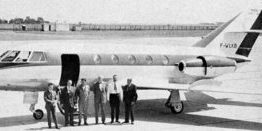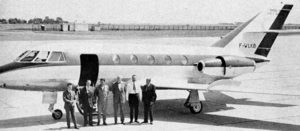Considerations to Keep, Sell or Buy
Older jet aircraft (25+ Years or older) are an interesting phenomenon in the market place. Many of these aircraft are trading at salvage value. Others are salvage value plus the value of the engines and major inspection status. Some feel operating older aircraft is OK, others are concerned about reliability and possible safety issues. Many banks will not make loans on older aircraft as future values are too hard to predict. Ask 10 aviation people and expect 10 variations from pro-operating an older plane, to others wanting nothing to do with an older aircraft.
The following are some considerations to help the reader formulate their own opinion on whether to keep or sell the old aircraft, or whether to take advantage of an inexpensive aircraft and buy one of these old aircraft.
First we need to clarify a few terms that are used in the appraisal world to help frame some of the issues that face the older aircraft.
Physical Life—The number of years that a new property will physically endure before it deteriorates or fatigues to the point of being unsuitable for its intended use. i.e. Corrosion, wearing out, fatigue.
Economic Obsolescence—Or external obsolescence, the loss in value or usefulness of the property caused by factors external to the property. i.e. New regulations.
Functional Obsolescence—Depreciation in which the loss of value is due to factors inherent in the property itself, technology, operating costs, changes in design and lack of utility. i.e. engine efficiency, avionics capability, lack of parts and operating costs.
Normal Useful Life—The planned life expectancy that the aircraft may reasonably be expected to perform the primary mission it was designed for when the aircraft was built.
Remaining Useful Life—The life remaining of the aircraft before retirement.
Effective Age—The apparent age of an asset in comparison with a new asset of like kind. This is the age that is indicated by the actual condition of the asset. (May be older than chronological age due to care and condition.)
The old straight pipe jets obsolescence was easy to recognize, as the engines were loud and not fuel-efficient. Fan powered jets marked a new generation with greater range, lower sound levels and more thrust. A layman could see the difference.
We have entered into a phase of the market this time that is slightly different and more difficult to discern than in the previous example. Engine technology has improved, however the delta between current engines and older fanjet engines is smaller. Other factors are still in play with older airframes becoming increasingly more expensive to maintain, certain parts becoming more difficult to procure, increased maintenance downtime, corrosion issues, and avionics packages that are not only more expensive to maintain, may need expensive upgrades to be able to fly how the original plane was designed to fly.
The results while not as easy to see, are just as real as before. Simply put, these older planes appear to still have physical life, however they have, or in the short term, will become either functionally obsolescent or economically obsolescent.
There is another portion of the story and that is in the science of predicting failures. The inspection process is designed around the philosophy of finding issues prior to them becoming flight critical. In the most simplistic form, if a crack forms at a certain point in time during testing, or actual in-service use, inspections are developed at a point in time prior to any possibility of that item becoming a safety of flight issue. The most common inspections are hard time inspections, on condition and those that are monitored. At this point in the aircraft’s life it is definitely best to have a maintenance facility with experience in make and model do the inspections.
But, as history has proven, can we really predict all of the possibilities? Unfortunately, many of the items that can become flight critical are hidden and can be in areas that we do not have good methods of detecting. Corrosion in certain areas deep inside joints or fatigue cracks that promulgate quicker than previously thought are just a couple of examples.
This generation of older aircraft were engineered using fail safe design philosophies, even though extremely rare, there have been accidents and incidents that inspections failed to predict a critical failure due to the location of the issue. Some are related to hours and cycles, some are related to the environment the aircraft has been operated in, and a few are related to the aircraft just being old. The FAA, as part of its aging aircraft program, has stated that inspection programs may not prevent some of these issues.
The bathtub curve for failures is a common analysis tool. Basically, it states that after the burn in rate/infant mortality, that products fail at a normal rate up until the wear out phase. Modern production methods have significantly reduced the burn in/infant mortality portion of the curve. All components do not wear out at the same time leaving multiple components having different aging curves. However, ultimately, all components are subject to wearing out. (The military will rebuild wings and tails of aircraft to extend their life.) Many of these life limited components can be replaced. The typical business jet, more than likely, will have numerous life limited components replaced over time. These items extend the normal useful life of the airplane. Engine retrofit programs and avionics upgrades are other life extension programs that extend the remaining useful life.
Perhaps one of the harder systems to predict the health of is the wiring in the plane. There are miles and miles of wires in even the light jets. Studies have shown that all wires do age and the insulation becomes more brittle over time. Certain environmental factors can increase the aging process such as water, hydraulic fluids, jet fuel, de-ice fluids and cleaning solutions. It has been found that tight bends or stretching can cause more rapid aging of the insulation. (Modern aircraft route wires with radius tolerances determined to best practices.) Vibration and jostling of wire bundles, metal shavings from replacing screws, new installations etc., clamps and areas where after time the wire bundle starts to rub against the airframe or another component can all cause insulation to crack or deteriorate and expose wires. (Note, wires rubbing against these places are not by original design but could result in years of bumps and bundle movement.)
Inspections may actually have an influence on the increase of wire issues as the bundles are moved around inspecting other areas of the aircraft. There are also those wire bundles deep in the plane that would be nearly impossible to inspect. There are efforts to find methods of determining the health of wires but so far none are accurate enough.
A 25+ year old aircraft has had many stressors to the wiring. So, the plane might look good, have all of the corrosion remedied, many upgrades completed and still have wires that have been exposed to all kinds of stressors and in places that are deep in the bowels of the plane. In fact, some of the methods to increase the life of the aircraft with detailed major inspections, updated equipment might even put more stress on the wiring causing cracks in the insulation or issues with connectors. Check with the remanufacturers of aircraft for what they have found. Wiring is probably the highest risk factor in the older aircraft and even those with impeccable maintenance records.
A final consideration is the reliability and availability of the aircraft. Most people have a good idea of the reliability of their aircraft. Just as important is the availability of the aircraft. Down time to keep the plane flying in the safest condition takes more time the older the aircraft is. Older aircraft have more parts that need replaced, the inspections typically take longer to complete with more issues found to rectify, and parts availability becomes a factor. An aircraft that needs to be flown 450 hours per year, might not be able to keep up. On the other hand, it might do just fine for the person who only flies 250 hours per year in spurts allowing enough time to get the plane back into airworthy shape.
It is expensive to properly maintain older aircraft. When you calculate the cost of unavailability of the aircraft the dollars become even a larger consideration. Not calculating this number is not providing a full picture of the total economics of ownership. Airlines and high utilization operators are forced to know these numbers as it is the difference between poor service or increased overhead with more aircraft in the fleet to cover for the down time. This is the functional obsolescence part of the equation and the reason that the airlines retire older aircraft.
There are no simple answers to when to stop flying the old aircraft. Our suggestions are:
Perform an in-depth cost analysis that includes maintenance costs, residual values and the cost of lack of availability of the aircraft to accurately compare alternatives. Tracking both reliability and availability is critical to an accurate analysis.
If the decision is made to operate an older aircraft, maintaining the older aircraft by experienced mechanics in the model of aircraft is even more important than when the aircraft was new. Doing everything possible to maintain the integrity of the wiring is critical. When there are electrical issues, consider replacing large amounts of wiring if deterioration is found.
Aircraft can be flown for long periods of time with proper maintenance. However, the costs at some point in time outweigh the capital cost and the plane may not be able to keep the schedule that you need.
Mike McCracken is President of Hawkeye Aircraft Acquisitions. Mike has been in aviation since 1978. He is a 6,500 ATP pilot with three type ratings and sold new and used planes for two major OEM’s since 1985. He is a certified ASA Senior Aircraft Appraiser. Since 2014 he primarily assists clients with fleet analysis and acquisition of new and used aircraft.
Mike McCracken
www.Hawkeye-aircraft.com









